In small-sized kitchens, every millimeter is worth its weight in gold work surface. In the process of cooking, you cannot do without such an important item in the kitchen as a sink. To create a comfortable, functional and practical work area, choose a small kitchen sink.
Advantages of a small sink
Thanks to its ergonomic design and sufficient capacity, the small kitchen “toiler” is widely used for washing dishes, despite the presence of a smart device in almost every second home. household appliances designed to make life easier for people. In addition, the sink is convenient for defrosting and cleaning fish and vegetables, and cutting meat.

A small sink is the only one convenient option for compact kitchen
Often sinks are complemented with all sorts of accessories - removable or stationary cutting boards, colanders, automatic valves, dish drainers, baskets and holders. With their help, it is possible to create a full-fledged, multifunctional work area, where everything is at hand.
Advice. If you plan to install a food waste chopper (disposer) under the sink instead of a siphon, you should purchase a small model kitchen sink with a drain hole of 90 mm (3 ½ inches) diameter, which is the same size as the dispenser inlet.
Small kitchen sinks - disadvantages
If you have big family and you cook a lot, a small sink will not be able to accommodate a large amount of used dishes. You can't do without a dishwasher here. Designers believe that in kitchens with insufficient space, it would be optimal to place a small sink in the corner, but in this case, moving the sewer pipes may be necessary. In addition, in the corner area it is convenient for only one person to cook or wash dishes. It will not be very convenient for small people to use such a sink; in order to reach the “dead zone” they will have to stretch forward, which creates additional stress on the lower back.

A small sink will not be very convenient if you have a large family
What material to choose a sink from?
The washers perform the most grunt work in the kitchen. This includes constant contact with moisture, edible fats of plant and animal origin, dirt and acid, alkali-containing household chemicals, impact high temperatures. To ensure that the product maintains excellent performance properties and flawless appearance As long as possible, manufacturers are constantly improving the production technologies of their products. They use additives that improve the quality of products and cover the surface of sinks with special coatings. Traditionally, for the manufacture of this group of plumbing fixtures, the following are used:

Each material has its own advantages and disadvantages. Each of them requires an individual approach to operation and care, which must be taken into account. The choice in favor of one option or another depends only on your wishes and the overall style of kitchen design.
Advice. The basis of the choice is the size, shape, material of the sink and the type of its installation. In addition to them, you need to carefully consider some details: the presence of installation instructions and a warranty card, the quality and completeness of the necessary mounting elements, mechanical integrity, complete set (siphon, ).
Sink configurations
Today the domestic market is simply overflowing with plumbing products various designs, designs, functional content and configurations. Therefore, choosing the most stylistically and technically appropriate solution is quite easy. Let us briefly list the main parameters of these products. They can be with one or several bowls, the radius, slope and depth of which vary depending on the purpose, and are available in the following shapes:
- round or irregular in shape;
- triangular with rounded edges;
- rectangular;
- square.
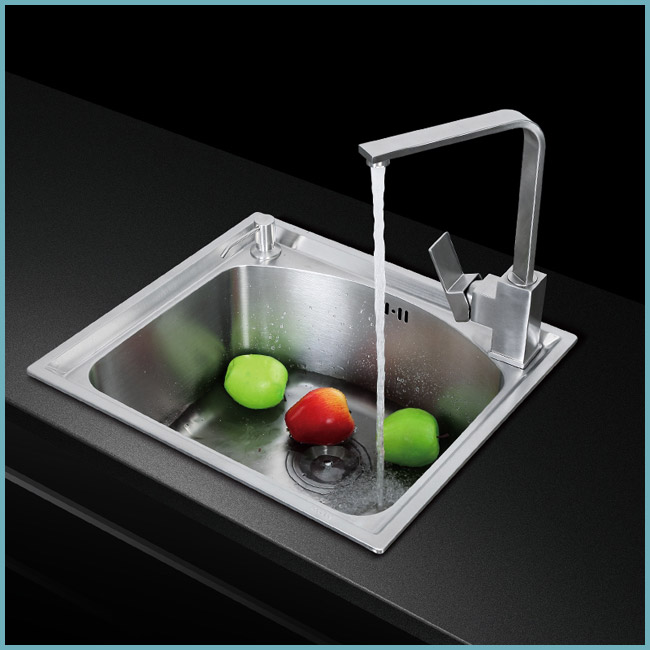
Square sink
Additionally, sinks are equipped with rectangular plates called dryers, wings or work tables. They are placed in the same plane as the tabletop. The dryers provide slight slope(about 2 degrees) towards the bowl, which allows water to drain freely. Depending on the design of the furniture set and the design of the placement of plumbing points, kitchen sinks are made in several types. In most cases, these are standard products rectangular shape oriented to the right or left for ease of installation. Available for sale and corner products. Their functional areas located at an angle of 45 degrees relative to each other.
Installation method
When choosing a small sink, pay attention to how the product is installed so that you don’t have to run to the store twice.

Undermount kitchen sink
- Mortise ones are installed in a pre-cut hole in the tabletop and the sides rest on it.
- Overlays are often used for mounting on modular furniture. They are installed on top of the washing cabinet, like a lid.
- Flush with the countertop (most often sinks made of artificial stone). Such sinks are more expensive and difficult to install, so it is better to entrust the installation to professionals.
- Mounting on the underside of the tabletop (under-table mounting). An under-counter sink is more convenient to use, but more difficult to install.
Advice. The area where the sink and countertop meet must be carefully sealed with sealant to prevent debris from accumulating under the edge of the sink and water from entering.
Siphon selection
In most cases, replacing a sink also entails replacing the siphon. When choosing the latter, you need to consider the following details:

Sink siphon with overflow and flexible pipe
- Diameter of the sink drain hole.
- Amount of space under the sink: height, distance between the walls of the cabinet.
- Diameter sewer pipe and the distance from it to the sink drain.
- Shape and color of release.
- Functionality: the presence of a plug, outlets for a dishwasher or washing machine.
- Material: plastic or metal.
- In addition, check the complete set of mounting components.
Purchase rules
When choosing kitchen fixtures, like any other product, you should be very careful. Indeed, along with certified products, you can find unlicensed goods on sale, the quality of which is questionable. Therefore, products should only be purchased from authorized retail outlets. In this case, it is necessary to check with the seller the availability of all documents: certificates of conformity.
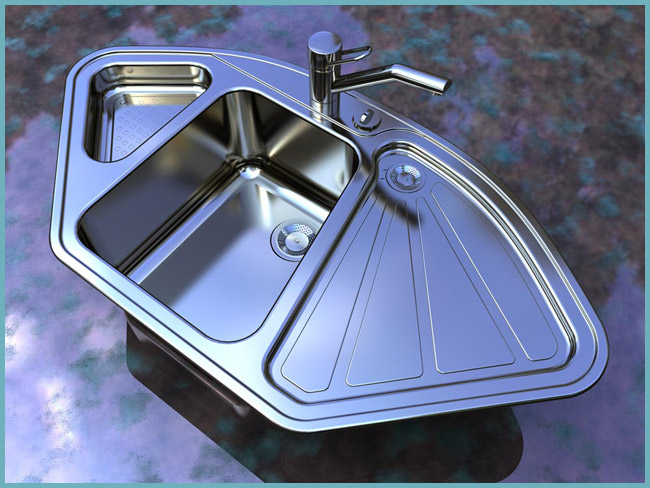
Give preference to a trusted manufacturer of kitchen sinks
What is a kitchen without a good sink? When choosing a kitchen sink, size plays a vital role. Only the perfect harmony of this important element with functional needs and aesthetic perception is able to provide comfort and practicality. The problem of sink size should be resolved before you get to trading platform, where the eyes run wide from the wide assortment. The purchase of this kitchen equipment must be made after carefully measuring the area and taking into account all kitchen furniture, interior and size of communications.
You can buy a kitchen sink only after accurately measuring and calculating the area of the room and its furnishings.
Features of the kitchen sink
The sink is the upper part of the cabinet into which a washing sink (or several baths) is built-in. The design of sinks should include a container in which the main process is carried out, and platforms for attaching the mixer and placing accessories, detergents etc. A platform (wings) may be provided for temporary placement of dishes before or after washing.
There are increased requirements for kitchen washing devices: mechanical strength(including impact), resistance to abrasion, scratching and cutting, tightness, water resistance (including elevated temperature), heat resistance, resistance to aggressive environments, ease of cleaning using detergents, etc.
Furniture size requirements

Sink dimensions are the most important parameter selection of equipment. In this case, not only the dimensions are important, but also the parameters of all constituent elements installations. The general dimensions are determined by the dimensions of the kitchen area where the installation of washing equipment is provided. Thus, the first important size of the sink is the overall parameters of its surface: length and width. The length is set by the distance from the wall to the first cabinet kitchen set or the distance between the cabinets. The width of the upper plane is determined by the width of the kitchen set - the equipment should not protrude beyond the boundaries kitchen facade. If the device is installed on a finished cabinet, then it is this cabinet that determines the dimensions of the tabletop.
An important parameter is the size of the washing container. They should allow the placement of large dishes and the required quantity at the same time; in this case, useful areas should remain on the surface. The second important size of the sink is the dimensions of the sink, such as length, width and depth. The parameters of the washing container are influenced by the size of the family and the overall dimensions of the countertop.
When choosing a sink, you should also take into account dimensions such as the thickness of the sheet from which the sink is made and the thickness of the countertop. The first size determines the strength and rigidity of the structure, and the second should not remove the sink from total height headset cabinets arranged in a row.
What types of sinks are there?
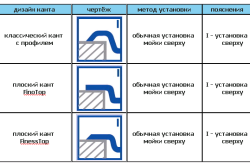
The size of the sink you choose depends on its type. The most common are the following standard designs. The traditional type is the invoice type, which is monolithic countertop, which is simply installed on top of the cabinet.
Its design includes a sink, the necessary platforms and mounting sockets for the mixer. The standardized dimensions of this sink allow it to be installed on any standard kitchen cabinets.
A mortise countertop sink is installed in a hole in the countertop made to fit the size of the sink. The edge of the sink or the wings (platforms) of the sink remain on top of the countertop. The surface of the sink protrudes above the countertop by 5-10 mm.
The fully mortise design allows for the sink to be inserted without a protrusion, i.e. flush with the surface of the countertop. Such a seam must be carefully sealed.
A type of overhead structure is a sink corner type, which has a wide wing that forms a right angle with the main tabletop. This design has significant dimensions, but allows you to optimally occupy an empty corner of the kitchen.
Shape and size of the sink
The sink sink may have different shapes. Commonly used are square, rectangular and round shapes, but sometimes oval and semicircular types are installed; It is possible to install a sink of the most bizarre shape, made to order. The shape is selected taking into account the optimal size and selected design.
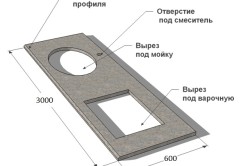
Square sinks are suitable for small kitchens, and their most common sizes are 40x40, 50x50 and 60x60 cm. The rectangular design fits into an elongated room and with a narrow kitchen set. The most common ones are standard sizes: 40x50, 40x80, 55x50, 50x80, 50x100, 50x125 cm. Finally, the round type refers to space-saving structures, and its standard diameter– 40-50 cm.
The depth of the sink increases its useful volume, but excessive depth makes it bend more when washing dishes, which is very inconvenient. The optimal depth is 16-20 cm. A smaller size leads to increased water splashing, and a larger one leads to inconvenience of maintenance. For small external dimensions of the sink, a greater depth is usually chosen - 20 cm or more.
A sink can contain more than just one sink; A common option is two sections, and sometimes even three. In this design, you can, for example, wash dishes and vegetables at the same time, and in the third bath you can rinse dishes or defrost food. Full two-section sinks start with a tabletop length of at least 80 cm. Smallest design has a length of 60 cm, but one of the containers in it has undersized overall parameters. The three-section design is more suitable for the corner option. The sizes of the shells can be either the same or different from each other.
Worktop under the sink
The dimensions of the sink countertop depend on the size of the kitchen unit and the total area of the kitchen. Typically, the width of furniture countertops is 50, 60 and 80 cm. Based on this, standard washing dimensions are established.
The washing surface is installed so that the cabinet protrudes in front of the facade by 5-10 mm, which is necessary to prevent streams of water along the facade. The sink in the sink should not be installed adjacent to outside– it should be removed by at least 5 cm so as not to get your clothes wet when using the equipment. On the back side, the sink can be located close to the wall if a waterproof apron is equipped, however, it is recommended to provide a gap of about 5 cm there too. The working wing of the washing surface should be located on the side working hand(for right-handers - on the right). Wing width – at least 10 cm. bottom connection water supply on the countertop there must be a platform for installing a mixer of the appropriate size. The most common dimensions of tabletops are 50x50, 60x60, 50x90, 60x90, 60x130 cm.
If there is a site for installing washing equipment longer than 90 cm, you can install a corner structure. This design will help make optimal use of the corner kitchen area. The width of the equipment in the part of the corner wing is 40-50 cm, which allows for free maintenance of such a structure. And on the rotated wing there can be an additional sink. The length of the protruding wing is 50-60 cm. When installing the third washing section in a corner system, it is advisable to choose a mixer with a shower.
The height of the sink surface is dictated by the height of the working surface, and the upper plane of the sink must coincide with the plane working area. Optimal height– 85-90 cm. The thickness of the overhead option is selected taking into account this condition and the height of the cabinet on which it is installed. The thickness of the sheet from which the washing container and the entire installation are made is determined by the material and strength characteristics. For of stainless steel a thickness of at least 0.8 mm is selected. Optimal thickness sheet, providing the necessary rigidity of the system, is 1.2 mm or slightly more.
A sink is an item that is chosen to suit the “dimensions” of the furniture. Therefore, you need to carefully correlate its width, depth, contour shape and type of installation with the actual situation in a particular kitchen. What should you pay attention to?
- 1 of 1
On the picture:
Only lightweight faucets are allowed on stainless steel kitchen sinks.
In the photo: mixer 60555 from Newform factory.
Washing hardness
Dictates the type of mixer. The value depends on the rigidity of the sink structure. Thus, heavy faucets weighing at least 6.5 kg are installed only on sinks made of stone and composite, but not on stainless steel models. As an alternative - wall mounting or installing a mixer in the countertop next to the sink.
Bowl dimensions
Matching cabinet cabinet. At standard width cabinets from 450 to 1200 mm, the width of the sink should be such that the bowl of the overhead sink (or several bowls with drain fittings- siphon) fit between the side walls of the cabinet without any problems.
The traditional width of the sink (its bowl) for a 600 mm cabinet is about 400 mm. Its depth is approximately 171-195 mm. If you bake a lot (wash baking sheets) or like to cook in large containers - a wok, for example, you need a deeper and wider bowl. There are such models, their depth is 200-205 mm. But with increasing capacity, you will have to bend more over the sink. Therefore, it is best to raise the cabinet into which it will be built to 105 cm (usually the sink is installed at the level of the main countertop, i.e. 85 cm from the floor).
Bowl capacity depends on the internal depth of the bowl and the radius of curvature of the bottom and side surface. A smaller radius (the walls are almost at right angles) means a more spacious sink.
In the photo: sink 6705 01 XX from Villeroy & Boch.
Sink shape
Model outline. When we say “rectangular” sink, then we're talking about about the external form - the contour of the model. In this sense, there are a majority of rectangular sinks on the market. But the bowl of a rectangular sink can be rectangular, round, oval, triangular, or in the form of an asymmetric drop. Round bowls are considered the most spacious.
Number of bowls. The main large bowl is often accompanied by a small one - an auxiliary one, most often of a smaller size. Such sinks are called one and a half cup sinks. Products with two or even three bowls allow you to perform several tasks in the kitchen at the same time. The presence of a wing on the sink, preferably a corrugated one, will make work in the kitchen easier.
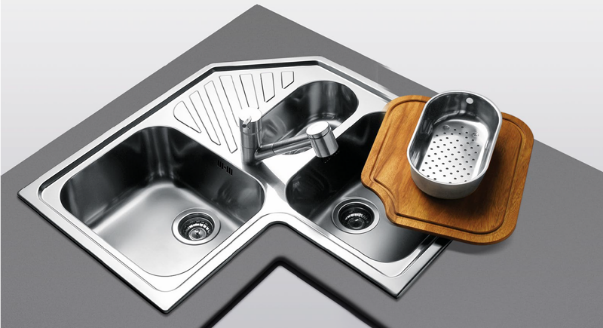
- 1 of 3
On the picture:
For those who cook a lot in the kitchen, additional features and more comfortable working conditions will be provided by sinks with two or three bowls.
Types of sinks
- Traditional: overhead sink. Attaches to a cabinet instead of a tabletop. An overhead sink has one drawback: water can leak between the sink and the adjacent cabinet. The model with a wall rim prevents water from flowing out of the bowl. The disadvantage of an overhead sink with a dryer wing is that water can leak between the sink and the adjacent cabinet. But this is perhaps the only solution for economy-class kitchens: the size of the sink is standard and fits standard-sized cabinets.
A built-in kitchen sink is easy to install: the hole in the countertop under it does not have to be perfectly flat, because... she will cover its edges with her edging.
In the photo: BLANCO MODEX-M60 sink from the Blanco factory.
- Easy to install: drop-in sink. During installation, extensive processing of the hole in the countertop is not required - the edge of the hole masks the edging of the sink. It is only important to treat the joints with sealing tape and sealant. A profiled edging or, as an option, a flat edging protrudes 5-10 mm above the tabletop.
- Difficult to install: completely mortise. The sink is located flush with the countertop (due to flat edges) or even flush. At the same time, the edge of the hole in the countertop, especially if it is made of stone, must be perfect. A completely flush-mounted sink requires thorough sealing. Variety mortise sinks- models installed below the level of the top (the so-called under-table integrated). They have many advantages: a wide range of sizes, absolutely any shape and, most importantly, increased internal depth.
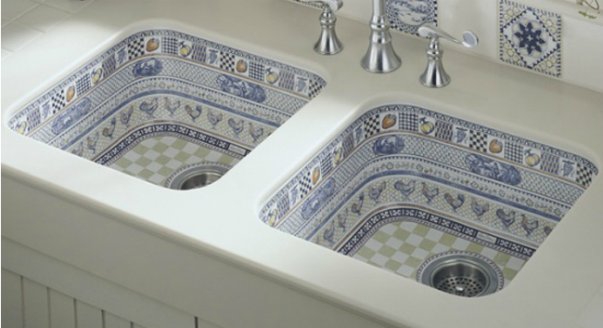
Comment on FB Comment on VK
Also in this section

Specialists German company BLANCO told what you should pay attention to when buying a new sink - so that you don’t have to change it long years.

The cheapest kitchen sink is just a container with a drain hole, the most expensive is a designer object with several bowls and/or wings, complemented by convenient accessories. Let's explore the differences.
A real housewife spends a lot of time in the kitchen.
But even more - near the kitchen sink.
That is why the sink should be comfortable, beautiful and not cause negative emotions.
Being in the kitchen should simply be a pleasure.
Convenience, functionality, beauty
Having developed a design project for your future kitchen, you can’t help but think about which sink to choose.
And here everything matters - dimensions, capacity, material, model and aesthetic appearance.
These are the main points that you have to pay attention to when choosing a kitchen sink.
Linear dimensions
Practice shows that the larger the sink, the more convenient it is to use.
However, taking into account the small size of many kitchen premises modern apartments, unfortunately, you will have to give up a large sink.
There will simply be nowhere to mount it.
For a small kitchen, you need to choose a single-section sink or a sink with a small wing for drying dishes.
If you still have a great desire to install a sink with two bowls in such a kitchen, then best suited corner option– usually in any kitchen the corner at the junction remains unused.
If the kitchen allows you to accommodate more than just a single-bowl sink, then you should definitely take advantage of this.
You will never regret allowing a two- or even three-piece sink to be installed in your kitchen.
After all, each section can be used for its own purposes, which will ensure comfort when preparing food and the necessary hygiene.
When determining the linear dimensions of the sink, you need to focus on the dimensions of the countertop. The width of the sink should be 5-10 cm less than the width of the countertop. This is necessary so that you can cut a hole in the countertop for the sink, and the edge of the countertop does not lose its rigidity.
Bowl depth
- The golden rule of life is: “Everything should be in moderation.” And it works even when you need to decide what depth to choose for the washing bowl. If the bowl of the sink is not too deep, then washing large pots, pans, lids and baking sheets will not be an easy task, because they simply will not fit in the sink. And the splashes from the water will scatter in all directions, and not be reflected from the walls of the sink.
- If the bowl is too deep, you will have to constantly bend over it. That won't do it either homework lighter and more pleasant - a tired back after washing dishes will make itself felt.
- Standard dimensions for washing bowl depth, which will provide maximum comfort for a housewife, they will be in the range from 16 to 20 cm. With such a bowl, even large dishes will be easily washed, and your back will not strain.
Wall thickness
- When choosing a kitchen sink, be sure to pay attention to the thickness of its wall. First of all, this applies to choosing a stainless steel sink. If the thickness of the stainless steel is less than 0.6 mm, this means that the sink was not made in accordance with GOST and literally within a year it may become unusable due to corrosion. In addition, the sound of water falling into such a sink will spread throughout the entire apartment, and the peace of the household will be systematically disturbed.
A high-quality stainless steel sink should have a bowl with a thickness of 0.6 to 1.2 mm.
Sinks made of natural or artificial stone, acrylic and ceramics have excellent sound insulation, so such a parameter as wall thickness is most relevant only for stainless steel sinks.

Cabinet in the morning, sink in the evening
The question of the size of the cabinet, or underbench, for a kitchen sink arises if you plan to install the sink using an overhead method.
In this case, it is necessary that the dimensions of the sink exactly match the dimensions of the cabinet, otherwise high-quality installation will simply be impossible.
The standard size of the cabinet is 60 cm, but there are options presented in 40-45 cm and even 35 cm.
In any case, you first plan what the size of the sink cabinet will be and only then purchase the sink itself.
Kitchen sink shape
Kitchen sinks come in different shapes.
Buyers can choose from round, rectangular, and sometimes even triangular and trapezoidal sinks.
If the sink is ordered individually, its shape may have more bizarre shapes.
Oddly enough, round kitchen sinks are more spacious than sinks of other shapes.
When choosing a round sink, there is one more parameter that you need to pay attention to.
This is the radius of the rounding from the side wall to the bottom of the sink.
The more this radius approaches a 90-degree angle, the more stylish the sink will look.
However, washing such “corners” is not very convenient.
Here the question is what to choose – convenience and comfort or style and beauty.
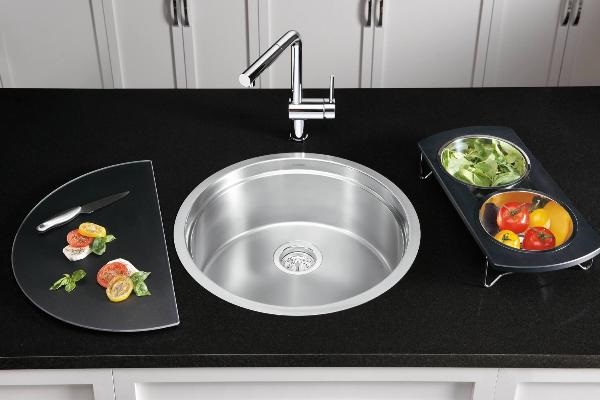

One, two, one and a half or three bowls - that is the question
The size of the sink directly depends on the number of bowls.
A sink with one washing bowl takes up the least space.
One-and-a-half-section sinks are an offset version of a double sink with a second bowl more small size, intended primarily for washing vegetables and fruits or for defrosting food.
A two-section sink may not fit in every kitchen, but the use of a three-section sink automatically presupposes the presence of a large and spacious kitchen space in an apartment or house.
By the way, sometimes in the wing of a kitchen sink you can see an additional bowl with a depth of only 30 mm, equipped with a separate drain.
Such a bowl is just a dryer, but it is very convenient, because the water in it does not stagnate, but immediately drains.
The drying bowl can also be used to defrost food.

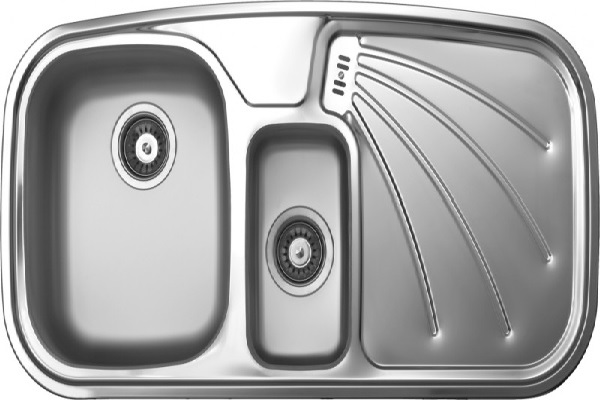
Corner sink - saving size
Being in a small kitchen, you want to feel even more comfortable, because its size, unfortunately, does not allow you to achieve the convenience that is easily created in a large kitchen.
One of the most effective ways The use of the kitchen space will be the installation of a corner sink.
If the depth of the tabletop is 60 cm, then the distance from the corner to the corner wall will be about 80 cm.
In fact, it can be difficult to even reach the end of this corner with your hand, much less make effective use of this distance.
Fruit vases or other decorative items are often placed there.
But can you afford to lose precious space in a small kitchen?
A corner sink fits perfectly into this corner.
Corner sinks come in either one or two sections.
If purchased kitchen sink with one bowl, then on the sides of it there are usually one or two wings for drying dishes.
If the sink is equipped with two bowls, then they are located at right angles to each other, and between them there is a place for washed dishes and a mixer.
Little tricks
- if your kitchen is equipped dishwasher, then there is no point in choosing a kitchen sink that is too large - the main thing is that the size of the selected model allows you to simply rinse even a large pan before putting it in the dishwasher;
- When installing a corner sink option, be sure to provide workplace additional source light, because with such an installation it often turns out that the back blocks both the light from the window and the light from the chandelier suspended from the ceiling;
- If you choose a large sink with three bowls, then you need to think about installing a faucet with a pull-out shower head, otherwise it will simply be impossible to reach all corners of such a sink.
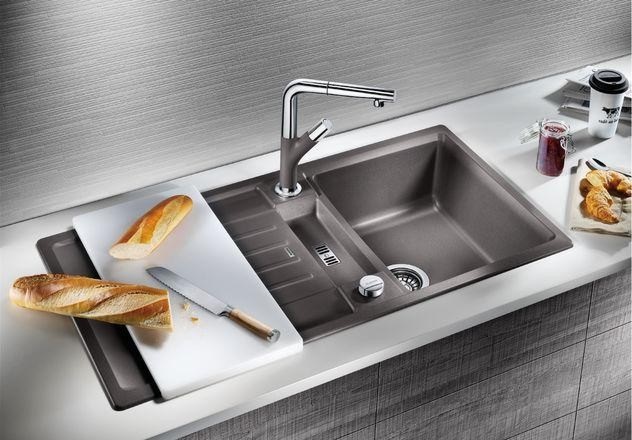
- After each use of a stainless steel sink, it must be wiped dry with a cloth to avoid limescale deposits.
- When choosing a cleaning product, you must first pay attention to the compatibility of its components with the material from which the kitchen sink is made.
- In order for the sink to last long enough, you need to avoid getting heavy, sharp objects or coloring products into it.
- The drain hole requires special attention, since it is where a large amount of dirt and bacteria accumulates. Periodically, the drain hole must be cleaned with a special solution: 1 liter of water, mixed with 1 tsp. a special disinfectant; chlorine bleach also works well.
- Sticking to these simple rules The lifespan of your kitchen sink can be extended for many years.
There is no universal kitchen sink, because all kitchens different sizes and layouts, and people have different habits and preferences. Let's figure out what shapes sinks come in, how to choose the most suitable one in your case and not make a mistake with the sizes.
Sink shape
Square. This shape is convenient for placing a sink even in a small kitchen if the countertop has standard dimensions. With sufficient depth, such a sink is quite spacious. Square sinks are often single, without additional functional elements.

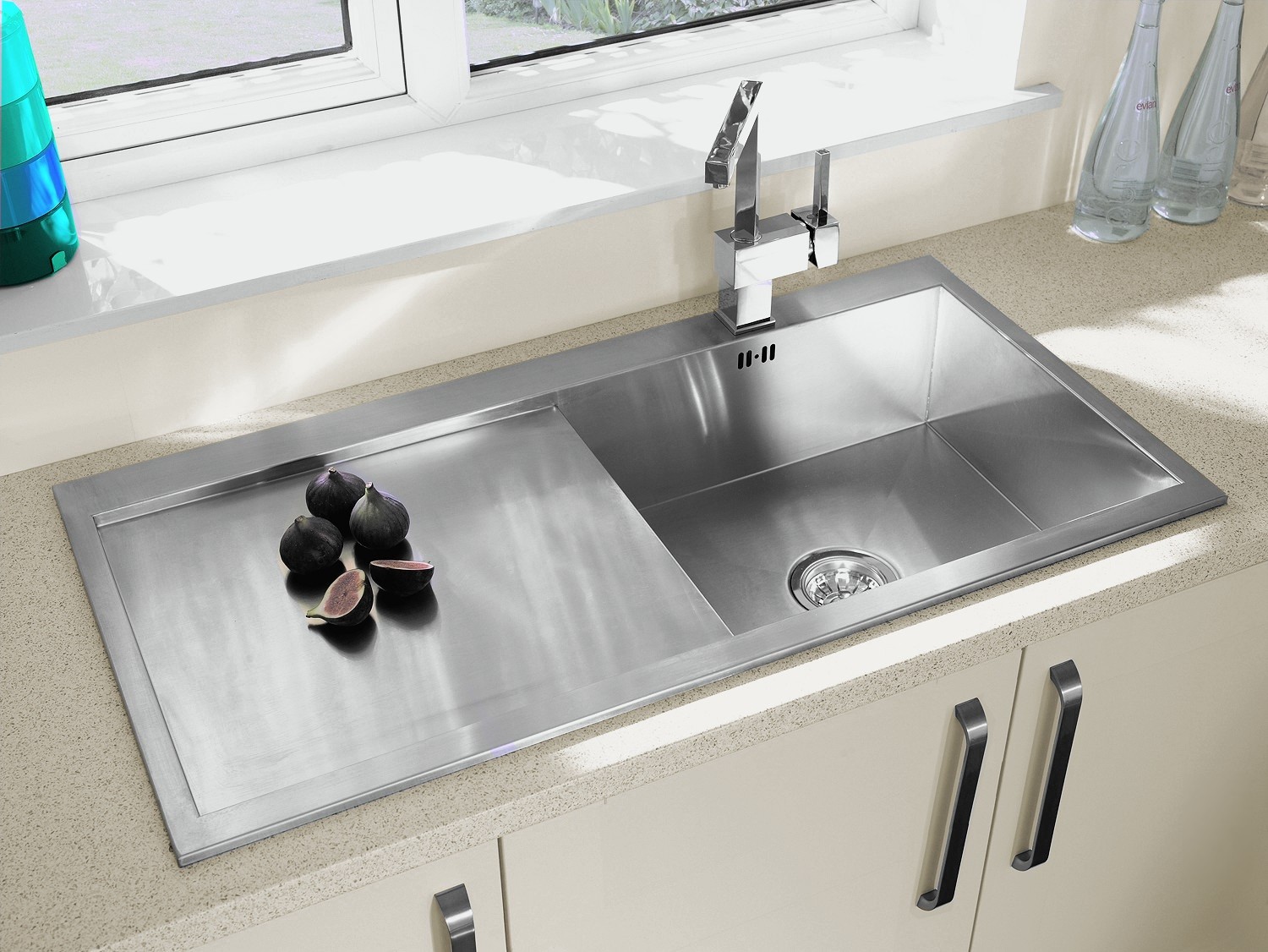
Circle or oval. The round sink looks compact and is easy to clean. At the same time, the capacity remains high: with the same volume, more dishes will fit in a round sink. This is the most convenient shape for corner placement, not counting special designs that will cost on average more than a round sink.
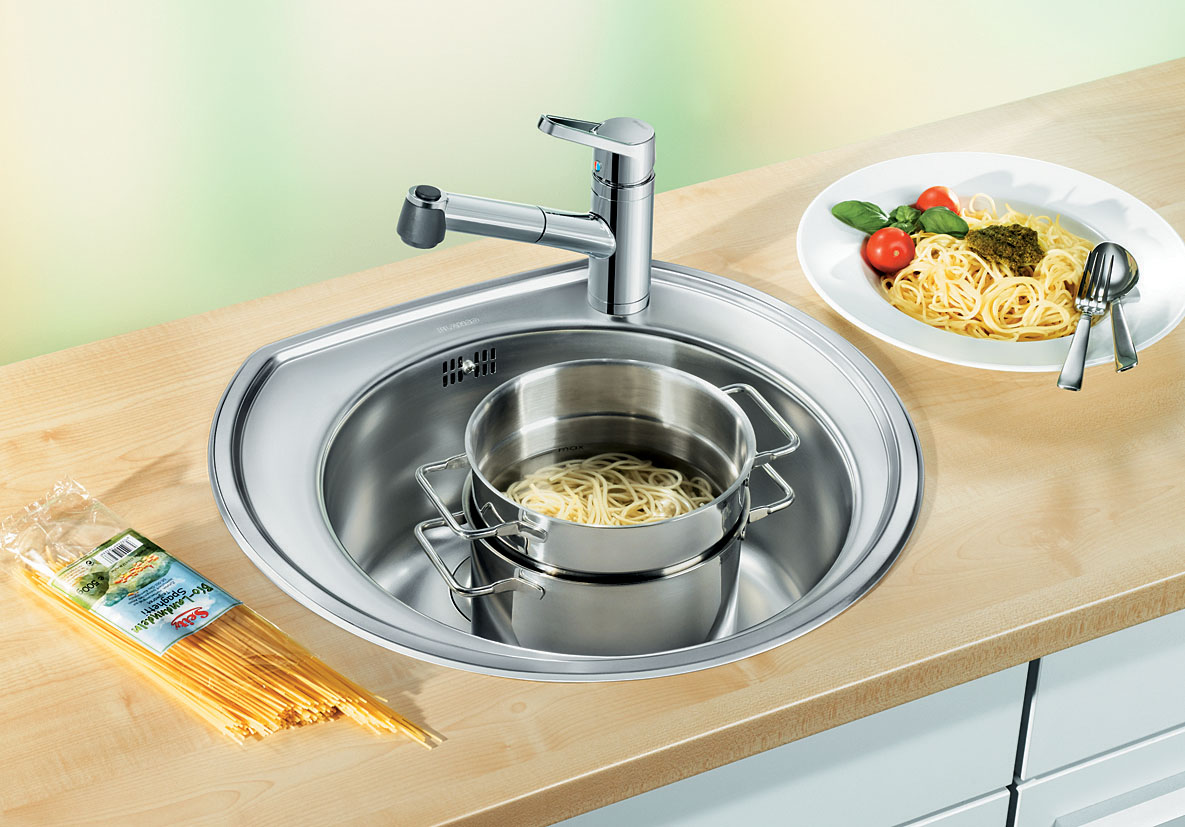
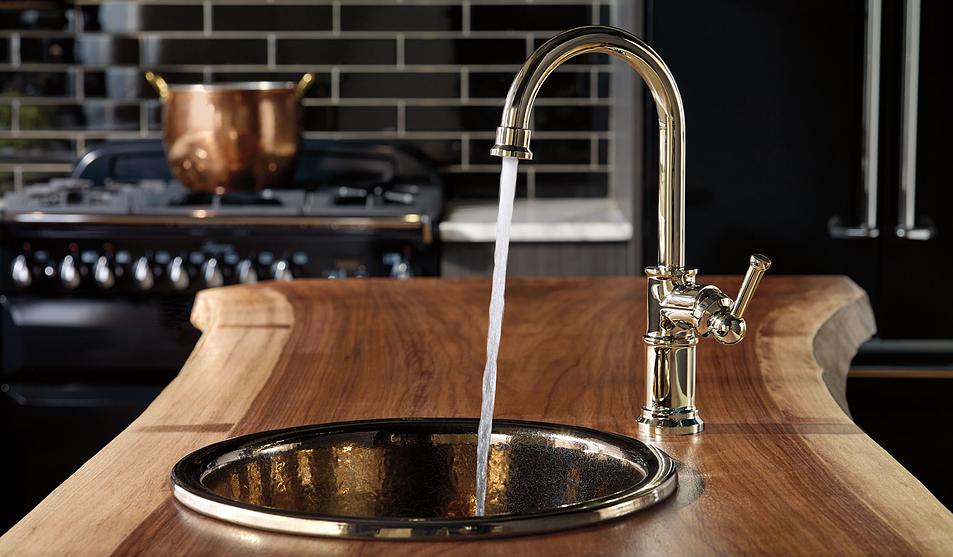
![]()
Rectangle. The most common form of kitchen sinks today, due to its functionality. The shape is convenient for placement on countertops of non-standard depth and opens up wide possibilities for equipping the sink with additional bowls, a wing or accessories.
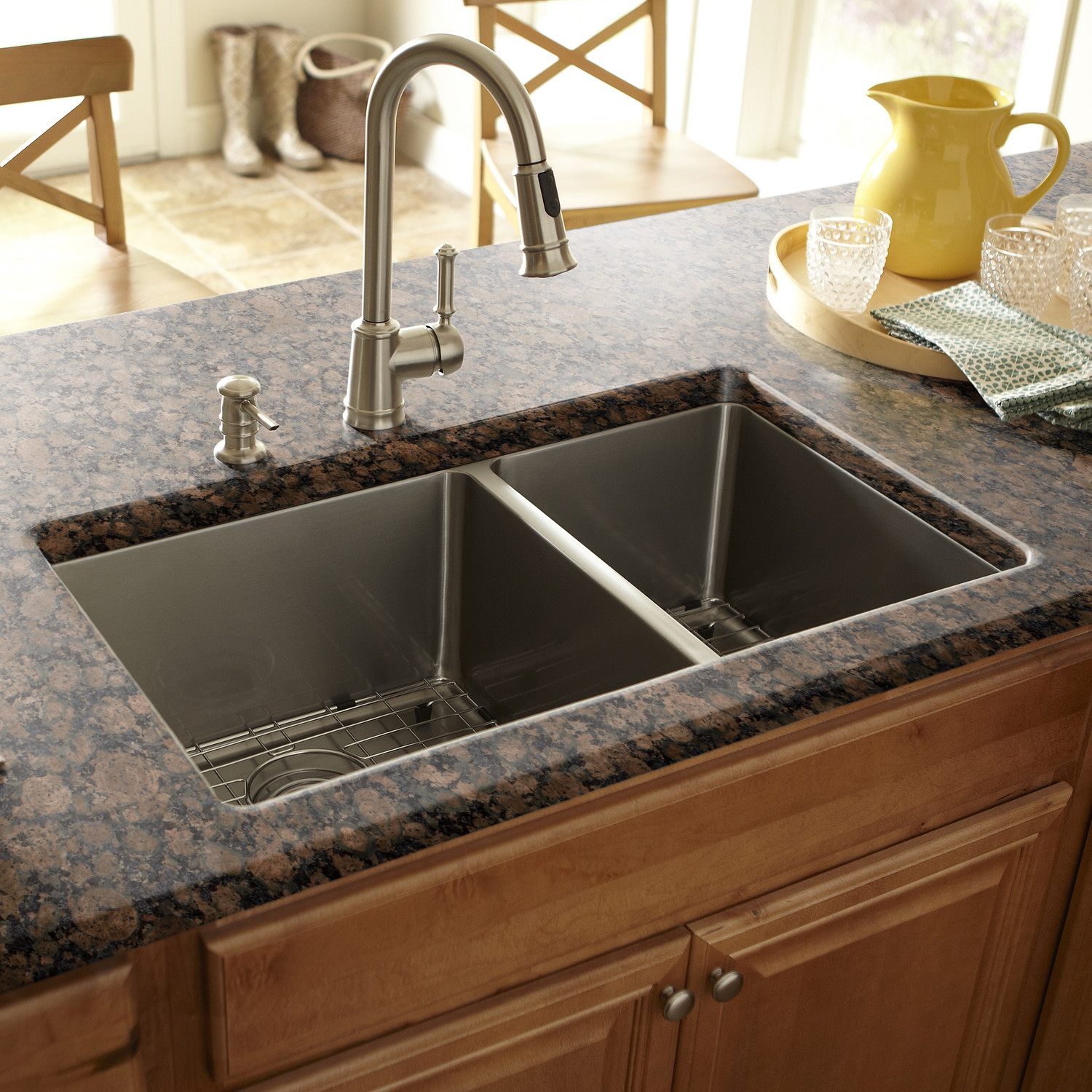
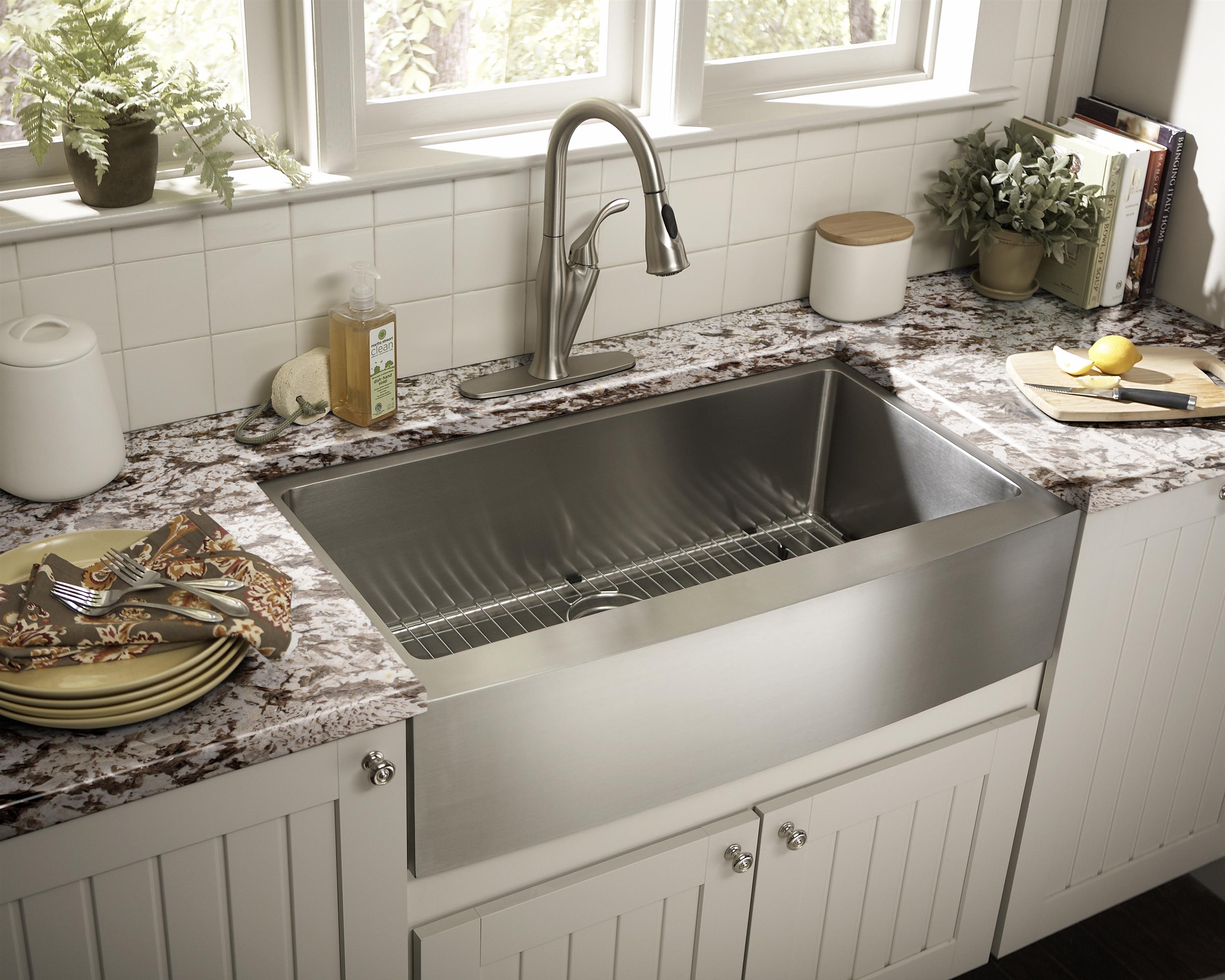
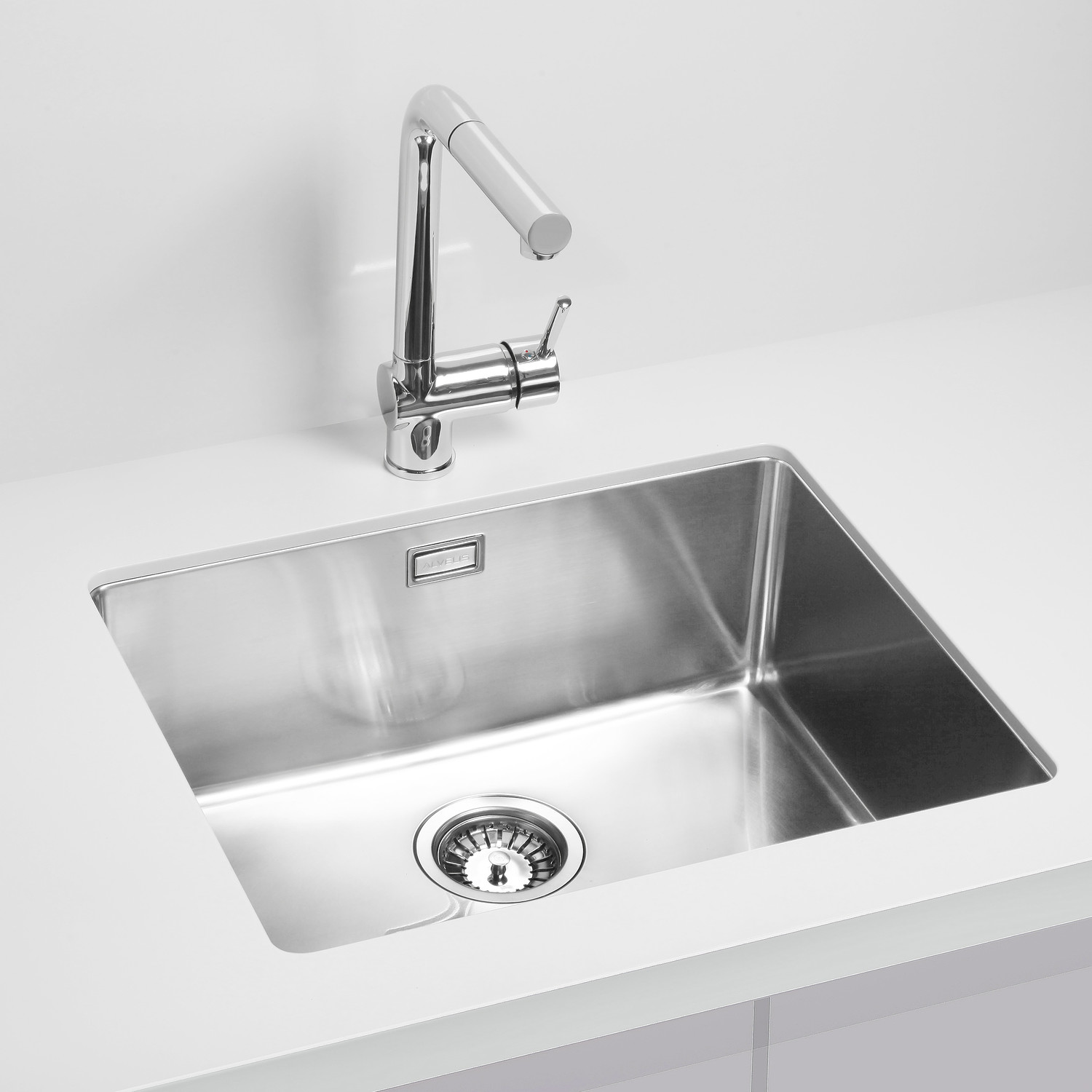
Corner. A special shape for placement in the corner, which greatly saves space. Usually on one corner design there are several bowls and a wing for drying dishes, often placed between the bowls for convenience.
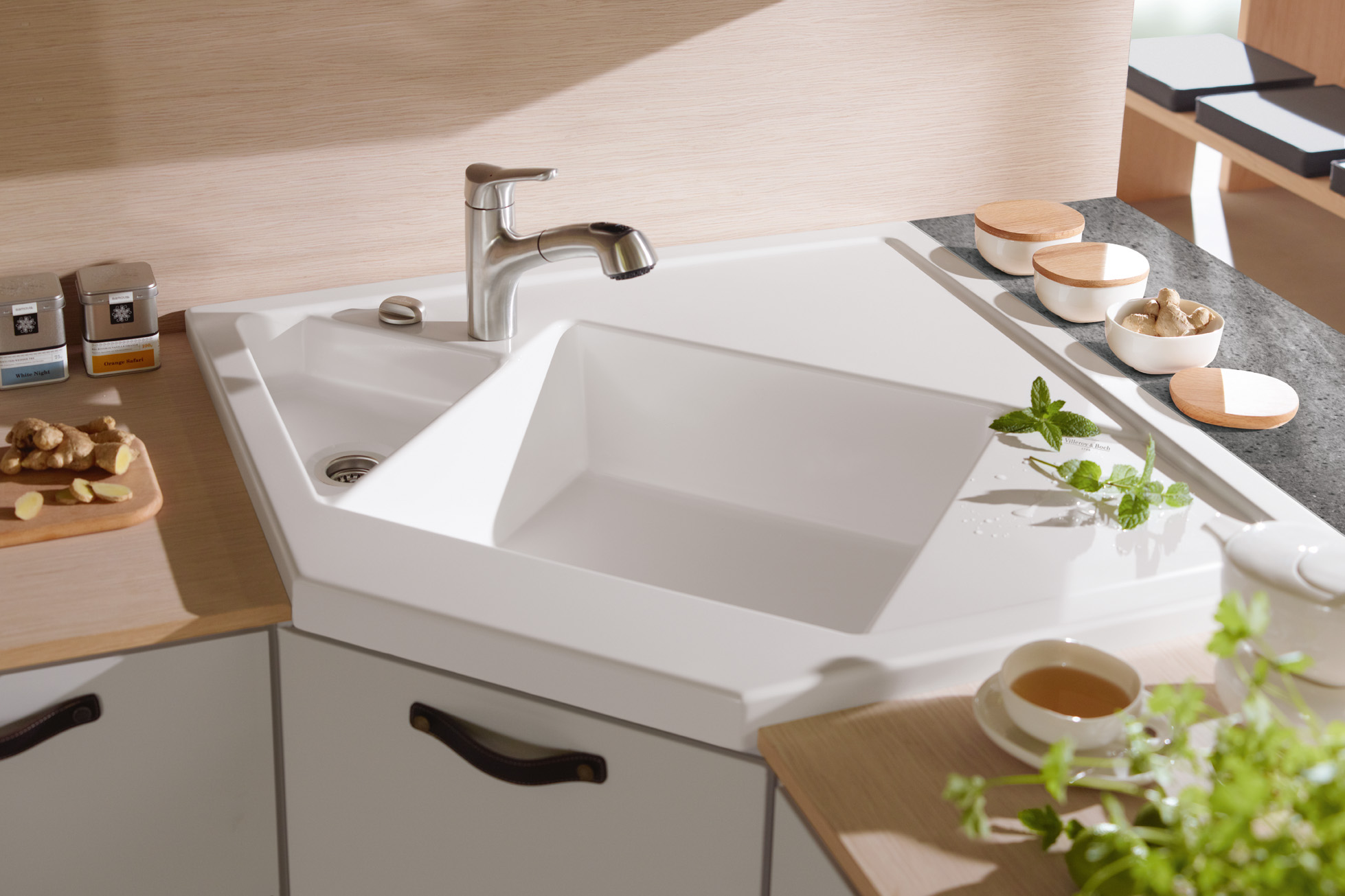


Non-standard forms. Among the range of kitchen sinks there are many designer ones - in the form of a drop, trapezoid, wave and others fancy shapes. It often happens that the sink itself is rectangular, and the bowl has a non-standard shape.

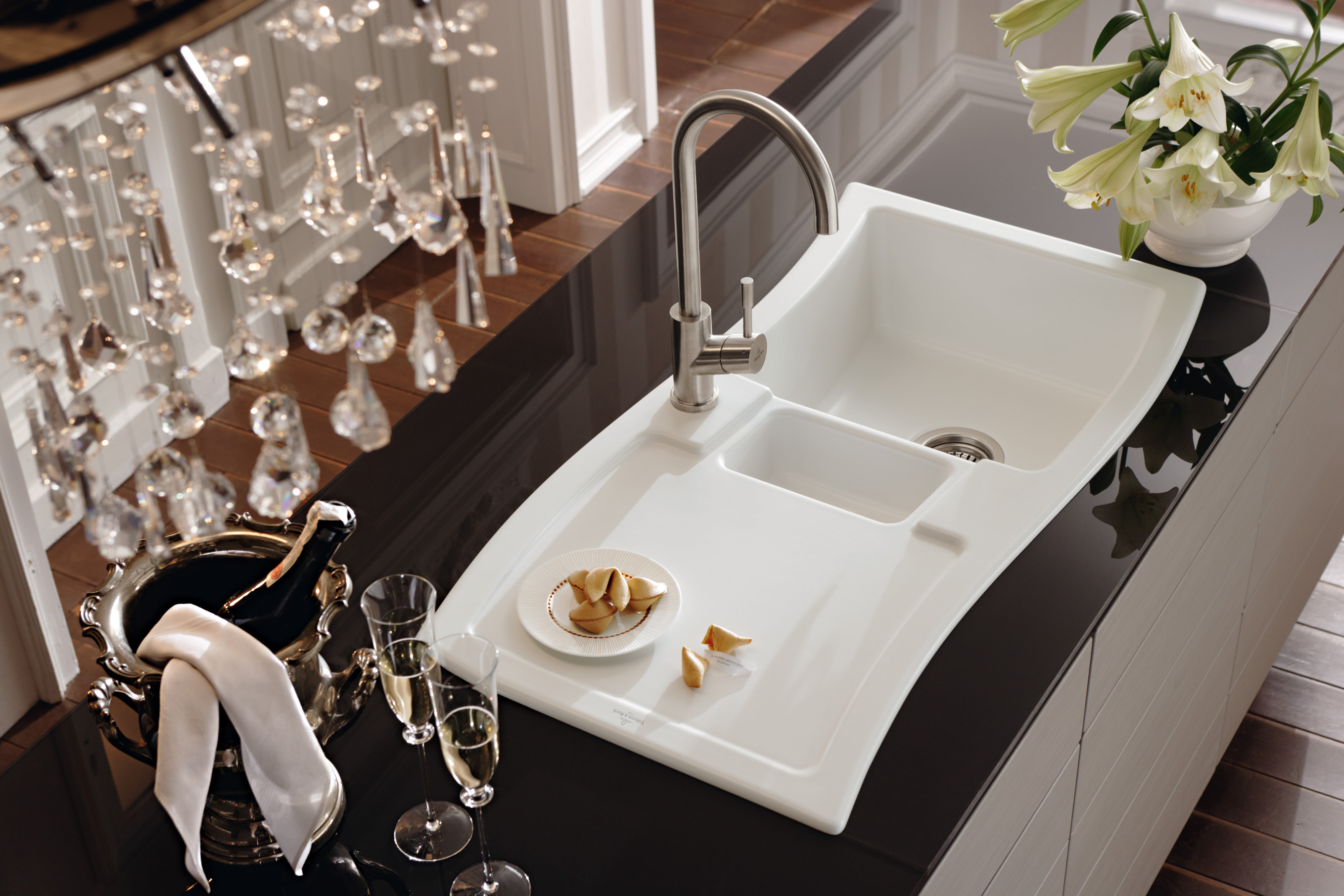
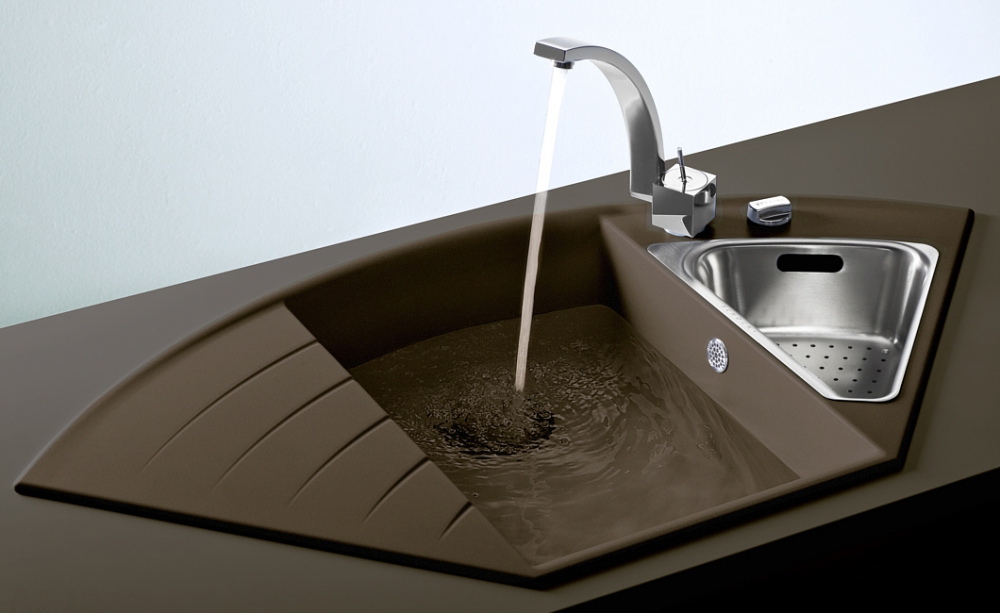

Functional
Sectional sinks. These are multifunctional sinks that have more than one bowl. The most common are double or one-and-a-half sinks. Double bowls same size, and in one-and-a-half the second is much smaller. Sinks can contain more than three bowls, but in this case you should take care of a special mixer: best suited with a retractable shower head. Even for double washing, it is better to choose a durable faucet so that it can withstand constant turning of the tap.
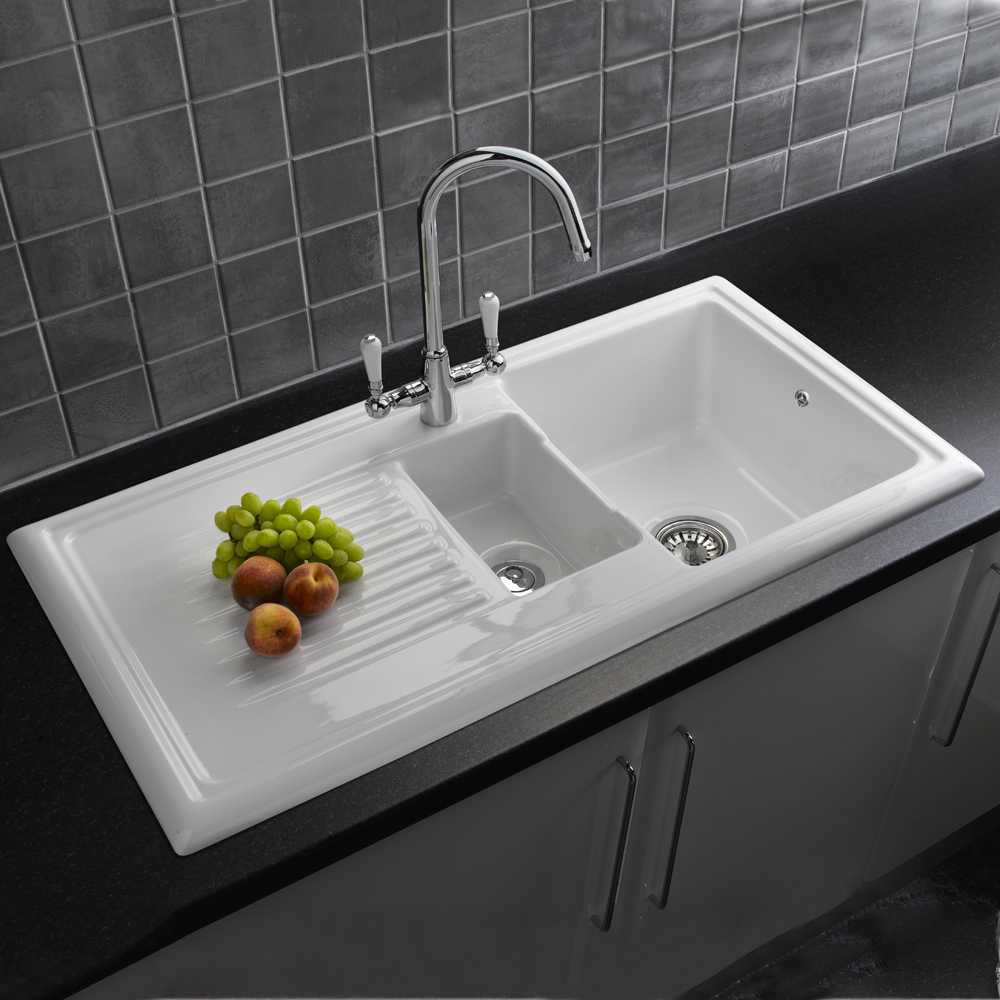
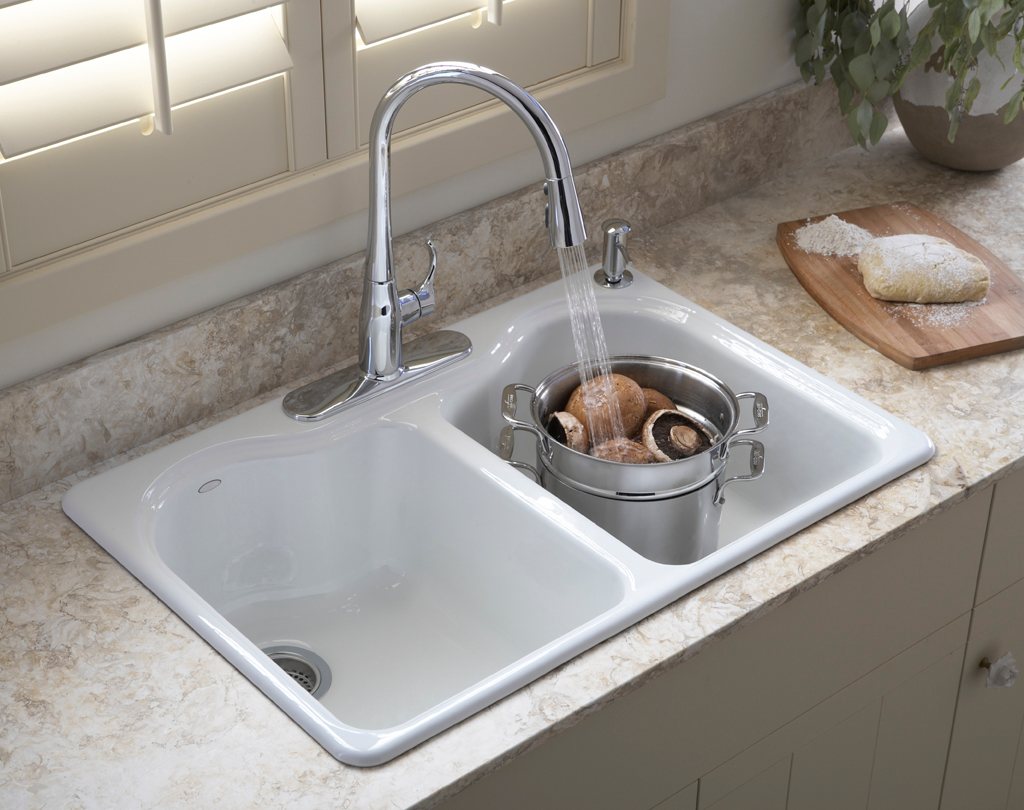
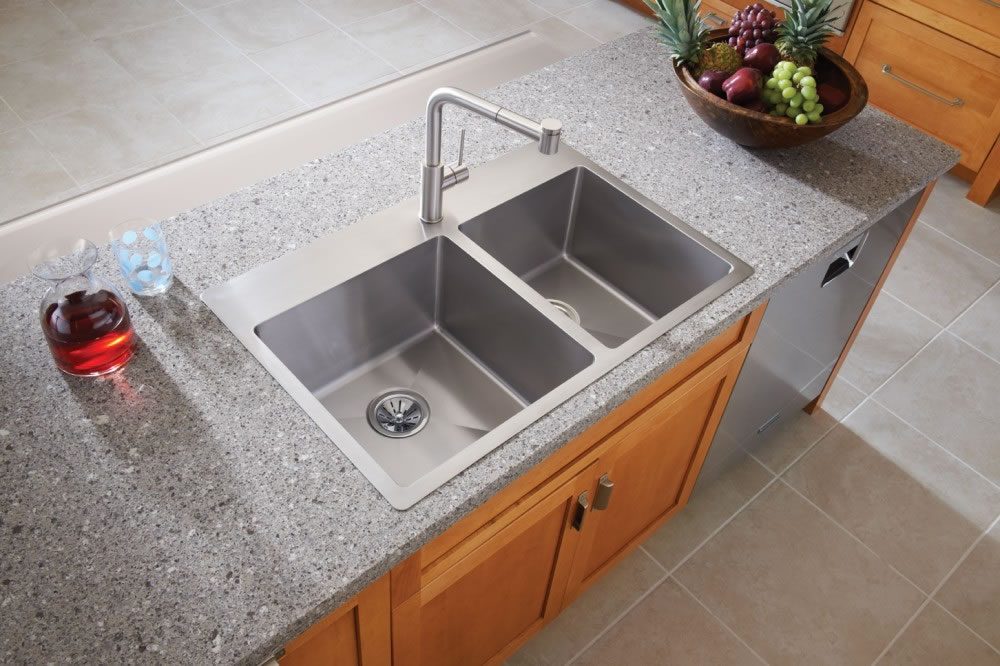
Sinks with a wing. wing - very practical element kitchen sink. It can be used not only for drying dishes, but also for placing hot pots and preparing vegetables. It is most convenient if the wing is located at a slight angle or has grooves, then the water will easily flow into the bowl.
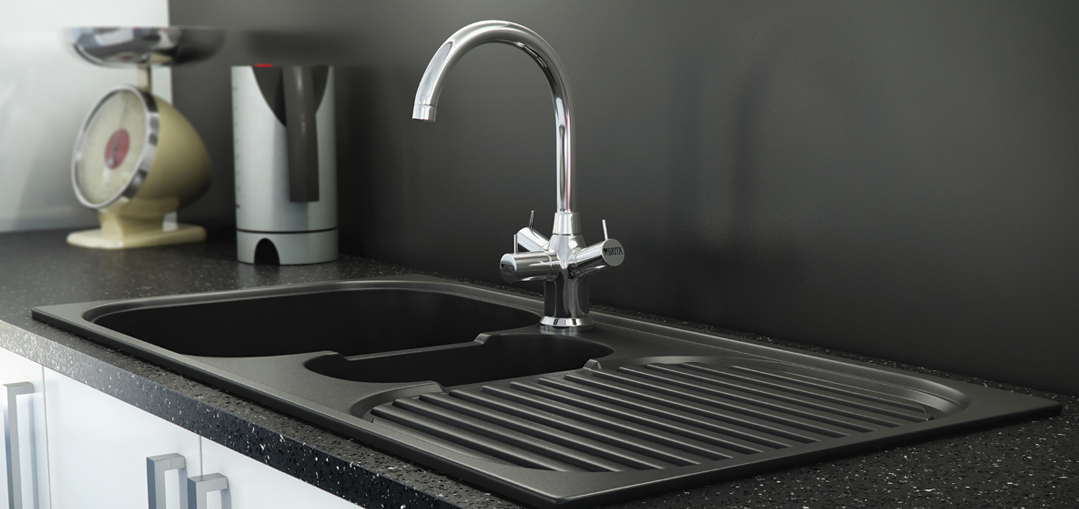
![]()
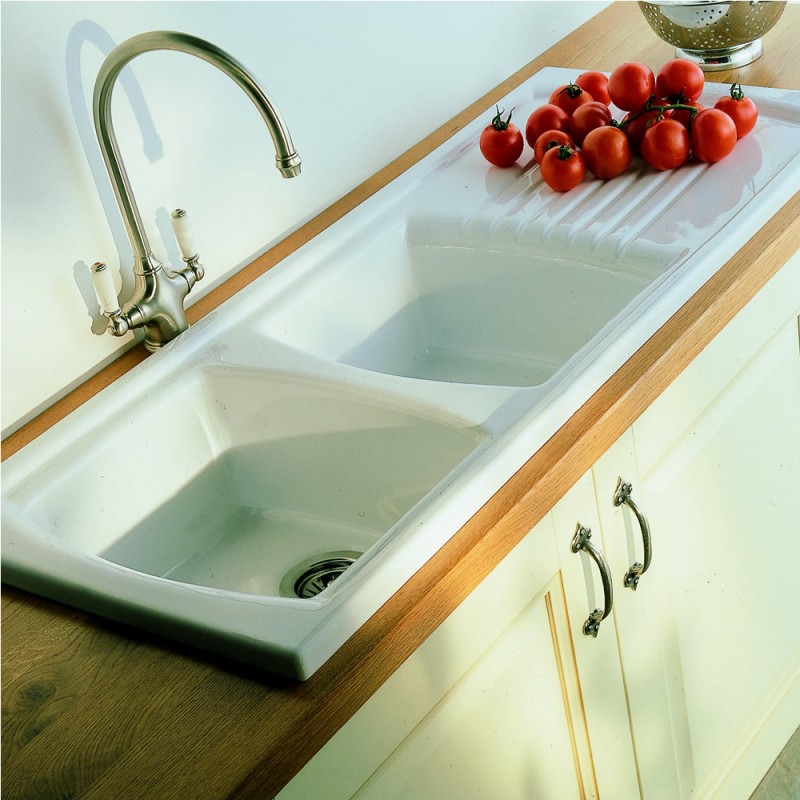
Sink dimensions
Lenght and width. The correct size of the kitchen sink in your case will depend on the depth of the countertop and the distance to other functional elements (stove, refrigerator, etc.). With a classic countertop depth of 60 cm, the sink should be no more than 50 cm, optimal size the bowl itself in the sink is 40 cm. Distance from kitchen apron there should be at least 5 cm to the sink for easy removal of moisture from this strip and less splashing of the walls. It is also better to leave a distance between the sink and the edge of the countertop.
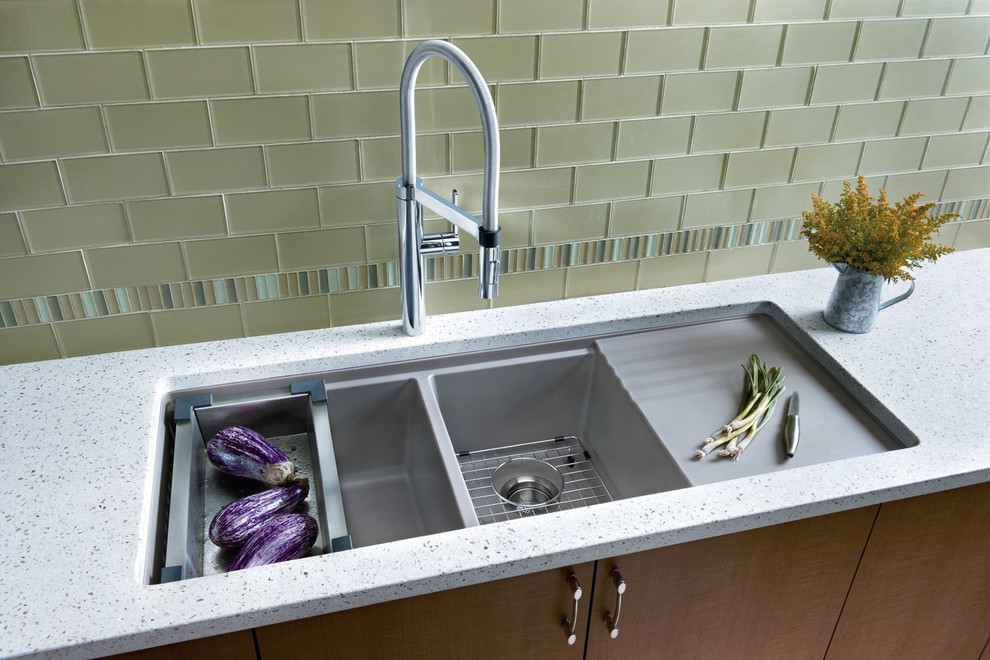
Of course, large sinks are more functional and convenient. But in a small kitchen, this will take up too much useful work surface, so it’s better to stick with compact versions. Also, the optimal size depends on how often you wash baking trays and bulky dishes. If so, then it is better to purchase a sink with a spacious bowl, but if the kitchen is limited, abandon the wing or the second bowl.
Depth. Standard depth kitchen sink bowls - 15-20 centimeters. If the depth is not sufficient, the sink will “splash” and hold less, and if the depth is too deep, you will have to bend over a lot when washing dishes.
Photos: goodtuesday.co, ghar360.com, ideas4homes.com, wayfair.com, diyremodelingideas.com
kitchen, how to choose



